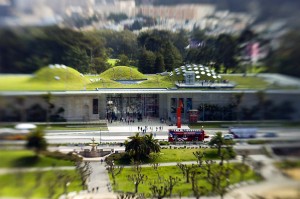 I’ve been going to the California Academy of Sciences since I was a little kid. I’m talking before I could walk and I loved the old place. There was tons of things to do and see and oh how I remember the awful cheeseburgers and fries served in the downstairs cafeteria by a company called Duchess.
I’ve been going to the California Academy of Sciences since I was a little kid. I’m talking before I could walk and I loved the old place. There was tons of things to do and see and oh how I remember the awful cheeseburgers and fries served in the downstairs cafeteria by a company called Duchess.
For a kid like me who was into science this was an awesome space because there was everything you could learn about, the Hall of Birds, the Hall of Minerals, Wild California, The Hall of Man, The fish roundabout, Life through Time, The Farside Gallery, the Elkus Gallery and of course the Planetarium and Aquarium. They also had a little know “Junior Academy” downstairs that offered Saturday courses to kids in the sciences from 5-18. The little kid classes didn’t work out so well, but that lead to the adding of the Discovery Center upstairs.
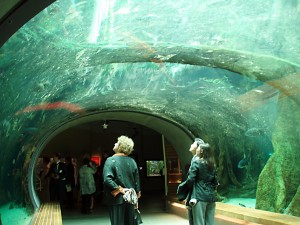 They also had regularly rotating exhibits that were usually pretty big. They had one on Shakespeare, Earthquakes, geez I a can’t remember them all. Then because of the 1989 earthquake there were a few problems and they just decided to rebuild the whole thing again and make it all snazzy and eco-friendly. Don’t get me wrong, I love the fact that they decided to twist a few heads with the bio roof and solar panels, but it’s not the same anymore. It’s all about the Aquarium.
They also had regularly rotating exhibits that were usually pretty big. They had one on Shakespeare, Earthquakes, geez I a can’t remember them all. Then because of the 1989 earthquake there were a few problems and they just decided to rebuild the whole thing again and make it all snazzy and eco-friendly. Don’t get me wrong, I love the fact that they decided to twist a few heads with the bio roof and solar panels, but it’s not the same anymore. It’s all about the Aquarium.
When you walk in you get to see the Piazza which one of the places to purchase an overpriced, but healthy organic snack. You head through there and can see the tops of a Philipine coral reef on one side and the Northern California coast on the other. The old grungy hall of reptiles has gone, but they saved the swamp area at least with a couple of gators and snapping turtles. Walk down a few stairs and you get the sparse swamp area. You can look into gator tank from below and there’s a few snakes and a lizard or two there. Of course they have to have a swamp/aquarium shop there as well. Then travel down a few more stairs and the Aquarium hits you. Big huge tanks with lots of fish. Not the 10’x10′ tanks you used to see in the old aquarium. Of course to balance this they have many more 10 gallon tanks in the walls, but over all you’re going to see a lot of stuff you’ve never seen before. My daughter loves the aquarium and even though she’s only three she has her favorite tanks she likes to hang out at and stare down the fish, That’s a whole ‘nother story I’ll get into later. So pretty much, the aquarium is very, very cool. So what else is there?
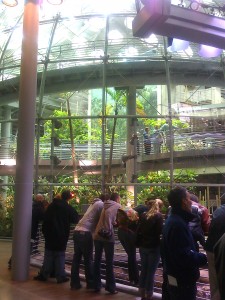 Well they’ve added something new and that’s the rainforest exhibit. To balance out the global shape of the planetarium the rainforest is a globe of glass that you have to enter through special doors so none of the stuff that’s inside gets out. Inside they have birds flying around, yet while I hear them I have yet to see them other than a macaw that tethered at the bottom of ramp just before you start traveling through the jungles. Each level has a different theme to it and in the small flattened areas to stop at they have…more fish tanks! plus some reptiles as well and it fits in nicely, but still, it’s all about the fish. When you get to the top which is the warmest place you’ll find lots of butterflies swarming around. They’re all pretty small so nothing freaky there. Now you can go back down and out so you go down an elevator after you’ve gone through a check to make sure there are no butterflies on you and that takes you all the way down to the aquarium. If you decide to go I suggest you start with the rainforest and head down to the aquarium because there are some things you’ll miss in the aquarium that aren’t too obvious when you first enter into it.
Well they’ve added something new and that’s the rainforest exhibit. To balance out the global shape of the planetarium the rainforest is a globe of glass that you have to enter through special doors so none of the stuff that’s inside gets out. Inside they have birds flying around, yet while I hear them I have yet to see them other than a macaw that tethered at the bottom of ramp just before you start traveling through the jungles. Each level has a different theme to it and in the small flattened areas to stop at they have…more fish tanks! plus some reptiles as well and it fits in nicely, but still, it’s all about the fish. When you get to the top which is the warmest place you’ll find lots of butterflies swarming around. They’re all pretty small so nothing freaky there. Now you can go back down and out so you go down an elevator after you’ve gone through a check to make sure there are no butterflies on you and that takes you all the way down to the aquarium. If you decide to go I suggest you start with the rainforest and head down to the aquarium because there are some things you’ll miss in the aquarium that aren’t too obvious when you first enter into it.
OK, what’s left? Well there’s the planetarium which I’d love to tell you about because I worked at the old one for four years, but I haven’t had the time to see it yet as I’m always there with my daughter and I’m not sure she’s ready to sit still for 45 minutes to an hour in the dark. I’ve seen videos of it and it’s real state of the art, so I’m looking forward to going once my daughter starts pre-school. They did manage to keep South African Hall, but made a few changes. Nothing too major, except for the addition of a tank of cichlids from lake Malawi and Tanganika in Eastern Africa that was originally the Charles Bange Memorial tank that was put in place by donations by the San Francisco Aquarium Society [note I was the president of the SFAS for 4 years and on the board of directors for 10 years]. Now it has someone else’s name on it so apparently the Academy has forgotten that many years ago the aquarium was kept afloat by donations from the SFAS and now the SFAS isn’t allowed to meet at the Academy anymore. The Herbst auditorium has been replaced with the Herbst Forum on the second floor and there’s also the Naturalist Center which is sort of a small library with displays of dead things or parts of dead things from the mammalogy and ornithology departments, but that’s it for the 2nd floor.
Other than that there’s a few small exhibits that don’t make up for what they didn’t keep in there. I noticed something when I was there today though. While they made it a little bit wider which is really mostly with outdoor garden areas, it’s much thinner. The swamp is at the back of the academy and that’s it. The aquarium used to run around it with other exhibits behind that. They gave up a lot that people can learn from. I’m not sure where the scientists do there work as in the old place there used to be two levels up with offices and labs and all the ichthyology and aquarium labs were down in the basement where the aquarium is now.
Now here is where the rants will begin. The real rants. When my wife and I got married in 1996 we got a family membership to the academy. It cost us…$25. With it we each got a card that would allow us to bring in a guest as well as 10 guest passes we could give out to our friends. It cost $7 to get in back then. We also got invited to a members only night where we could walk around the academy and get behind the scenes tours and feed for free.
Now, that same membership will cost you…$500! You can get the Family Plus membership, but you’ll have to pay $75 each for the behind the scenes tour. Ticket prices to get in are now $24.99 for adults, $19.99 for 12-17 and $14.99 for 4-11.
If you have kids, get a family membership. It’s $159 and you’ll get that back 10 fold in a short period of time. There is one thing to remember though, if you’re going to go you should take advantage of the members only hours of 8:30-9:30 on Tuesdays or 10-11 on Sundays. Especially if you have small kids. We went there about 12:30pm today and the place was packed. We couldn’t even let our daughter out of the stroller because we’d have lost her in seconds.
If you want to go on the cheap the last Thursday of the month is Nightlife where it will only cost you $12 to get in, but you have to be 21+ because they have bars set up all over the place. I haven’t been to one of these, but being a member I would still have to pay $10 in addition to the drinks.
I have to admit that I like the cafe that they have as they serve a wide variety of all organic meats and veggies with enough variety to suit everyone, but that all comes at a price. We tried it once and we got a breakfast quiche, muffin, coffee and an izzy’s soda for just under $15. The quiche was small, the muffin wasn’t very large, but the coffee and soda were good. Today, I noticed as we walked through the piazza that while there were people in line to buy food, most of the people there [some of which had to sit on the floor as there were no more tables] had brought their own food. The line to purchase tickets was at least 4 deep and 100 ft long. So I imagine that the wait would be close to an hour.
If you’re a member you get to put on your best smug face and walk through the members entrance where they not only ask for your card, but you ID as well to verify you aren’t loaning your card to friends. You also get a lot of other little discounts and benefits that you can find here. The funniest thing is that maybe we should have gotten an individual membership for $99 because it says you can bring a guest in with your card. It doesn’t say that with a family membership. So if you’re a couple and don’t expect to take any out of town relatives there that’s the best way to go about it. Overall, I’d have to say that the California Academy of Sciences has changed from a museum of science to a political show off piece. Gavin Newsom is even quoted as saying it’s his favorite place in San Francisco. You don’t get to talk to the scientists who are doing the work behind the scenes, but you can watch them through glass sometimes in the lab that’s open to the public for viewing, but no entrance.
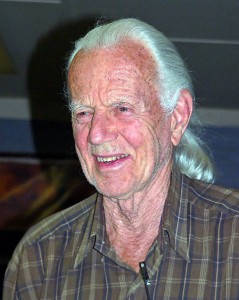 The Dobsonian telescope named after it’s inventor, John Dobson brought the heavens to a great number of people. It was fairly cheap to make, but gave you the ability to see things in the sky that most store bought telescopes would never let you see. The first time I got to see Saturn for myself was through a Dobsonian telescope and Jupiter looked huge and I could even make out more than the four moons you normally can see.
The Dobsonian telescope named after it’s inventor, John Dobson brought the heavens to a great number of people. It was fairly cheap to make, but gave you the ability to see things in the sky that most store bought telescopes would never let you see. The first time I got to see Saturn for myself was through a Dobsonian telescope and Jupiter looked huge and I could even make out more than the four moons you normally can see.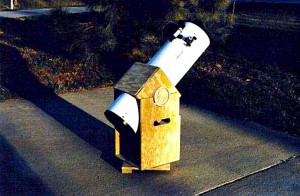 The process of making the big mirror for the telescope consisted of mixing some grit with water and putting it between the two portholes and rotating them in small circles. I think most of our neighbors thought we were crazy as my Dad on weekends would take the portholes out in the driveway and he and I would sit there for hours grinding away at the glass. Since my Dad only had weekends to work on the mirror and John always focused on perfection in the grinding we never finished the mirror, but we did get it as far as the pitch lap which I’m still not sure what part that plays in the mirror, but I remember it was the last step before your porthole became a mirror for your telescope. That and the tube for our 12″ telescope sat in our house for years until my astronomical friend Patty took them off our hands a few years ago.
The process of making the big mirror for the telescope consisted of mixing some grit with water and putting it between the two portholes and rotating them in small circles. I think most of our neighbors thought we were crazy as my Dad on weekends would take the portholes out in the driveway and he and I would sit there for hours grinding away at the glass. Since my Dad only had weekends to work on the mirror and John always focused on perfection in the grinding we never finished the mirror, but we did get it as far as the pitch lap which I’m still not sure what part that plays in the mirror, but I remember it was the last step before your porthole became a mirror for your telescope. That and the tube for our 12″ telescope sat in our house for years until my astronomical friend Patty took them off our hands a few years ago.




